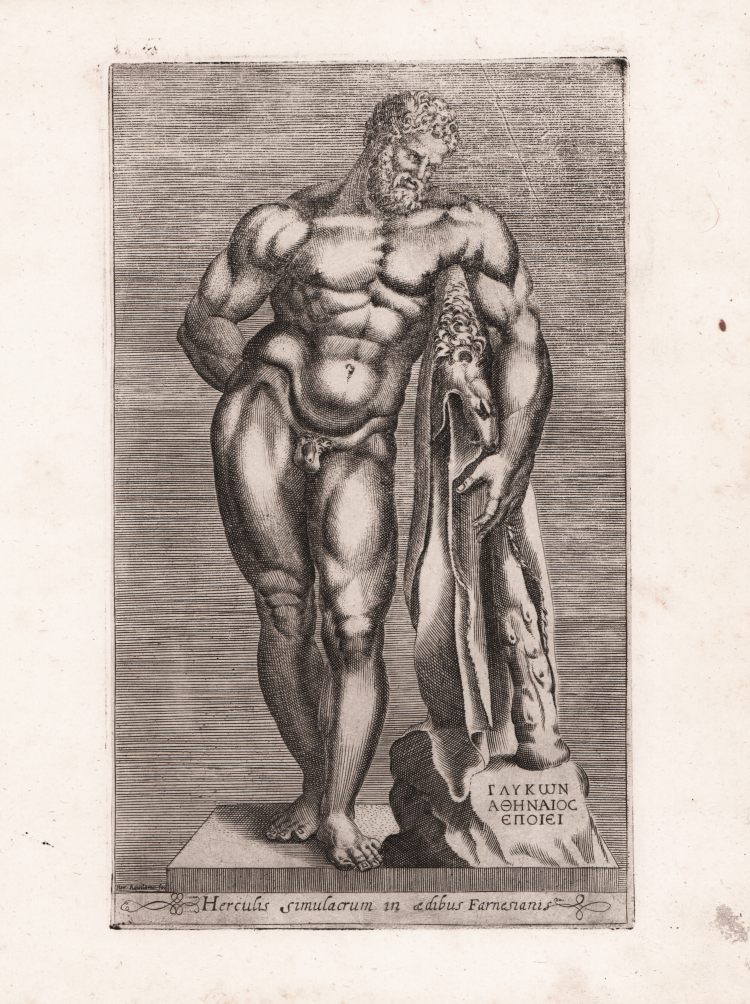



| Reference: | S36052 |
| Author | Orazio de SANTIS |
| Year: | 1584 ca. |
| Measures: | 130 x 220 mm |


| Reference: | S36052 |
| Author | Orazio de SANTIS |
| Year: | 1584 ca. |
| Measures: | 130 x 220 mm |
The Farnese Hercules is a 317-cm-tall Hellenistic marble sculpture by Glycone of Athens dating to the third century AD housed in the National Archaeological Museum in Naples. It appears to be a copy of the bronze original created by Lysippus in the 4th century BC.
Plate taken from the Antiquarum statuarum urbis Romae...Io. Baptista de Cavalleris authore, the first systematic collection of illustrations of ancient sculptures preserved in Roman collections, which is due to the work of the engraver and draftsman Giovanni Battista Cavalieri (1525 circa - 1601) in the second half of the 16th century.
Orazio de Santis and Cherubino Alberti also contributed to the engraving of the plates.
The repertory, a point of reference for antiquarian studies, was widely circulated and contributed to direct the interest of scholars of the time towards ancient statuary.
The number of plates, about 50 in the first editions (datable to about 1561/62) was subsequently enlarged; before 1584 books I and II were published with 100 numbered engravings of sculptures, organized according to the collections they belonged to. In 1594 come to the light of the III and IV volume of the work, in which appeared other 100 new tables, this time ordered according to the iconography of the subjects. The sculptures are depicted on neutral backgrounds, without architectural references.
The work, with the title Antiquarum statuarum Urbis Romae primus, undated, was first dedicated to Ottone Truchsess von Walburg - first as deacon of S. Maria in Trastevere (1561/62) and then as cardinal of Albano (1562/70). Later, with the title Antiquarum statuarum Urbis Romae primus et secundus liber, the frontispiece is dedicated to Cardinal Ludovico Madruzzo, and can be dated 1584/85.
In 1594, with the title Antiquarum Statuarum Urbis Romae tertius et quartus liber, one hundred new plates were published with a dedication to Cardinal G. Paluzzi degli Albertoni, dated June 1593. Please note that, while in the first two books the statues were published according to collections, in the third and fourth are grouped by subject. The collection contains, in addition to the engravings of Giovanni Battista Cavalieri some plates signed by Cherubino Alberti, Orazio de Santis and other famous engravers of the time.
Giovanni Battista de Cavalieri or Cavalleris was an engraver, printer and publisher. Born in Villa Lagarina, near Trento, is active in Venice (since 1559) and Rome, where in 1577 opened a workshop in the Parione district. He resided in the alley of Palazzo Savelli, with a studio near the house. He became brother-in-law of the famous publisher Lorenzo Vaccari. He made plates for Antonio Salamanca, Antonio Lafreri and Bartolomeo Faleti. He began to publish his works around 1560, but always in partnership with others: in 1567 with Perino Zecchini and in 1576 with Lorenzo Vaccari. In 1577 he hired a printer, Francesco Cornuti, publishing works by his contemporaries, including Francesco Salviati, Daniele da Volterra, Raphael, Michelangelo, Polidoro da Caravaggio, Livio Agresti and Baccio Bandinelli.
Engraving, printed on contemporary laid paper, in excellent condition.
Bibliografia
Thomas Ashby, Antiquae Statuae urbis Romae, in Papers of the British School at Rome, IX (1920), pp. 109-158;
Orazio de SANTIS (Attivo a Roma 1568/84)
|
Engraver and publisher active in Rome, whose work is almost entirely after Pompeo Aquilano - hence his nickname 'Aquilano'.
|
Orazio de SANTIS (Attivo a Roma 1568/84)
|
Engraver and publisher active in Rome, whose work is almost entirely after Pompeo Aquilano - hence his nickname 'Aquilano'.
|